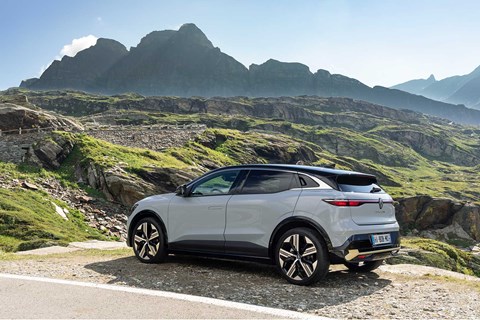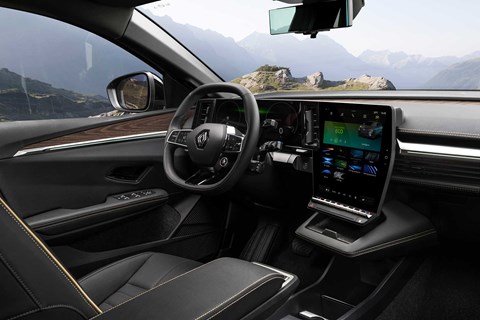► New Mégane Electric on UK sale autumn 2022
► Renault says it’s the EV for GTI fans
► Up to 292 miles of range
Renault is reinventing its Mégane hatchback as this zero-emissions car called the Mégane E-Tech Electric. Set to land in UK showrooms in autumn 2022, Renault is pitching the e-Mégane as the electric car for driving enthusiasts, with a low centre of gravity and quick steering.
It’s shaping up to be a serious rival for Volkswagen’s ID.3 hatch, with similar range (up to 292 miles) and performance, and plenty of innovations demanding 300 patents. Read on for the full story.
It looks familiar – but not exactly like a Mégane
The look is familiar because Renault has been announcing this model for almost a year, kicking things off with the Mégane eVision concept, to which the production car has remained pretty faithful.

Design director Gilles Vidal describes it as a ‘cross-hatchback’, and you can see what he’s getting at: the Mégane Electric has a crossover’s chunky presence, big wheels spanning 18-20 inches and a high nose, but actually stands only 5cm taller than today’s plain Mégane hatch (and at 4.21m is actually shorter).
And what’s under the skin?
The Mégane Electric is underpinned by a chassis specially developed for electric vehicles (which Renault and its partner Nissan, who uses it for the bigger Ariya, call the CMF-EV platform). With a shorter nose than combustion engine cars’, the wheels are pushed out towards the edges creating a decent space for the batteries, and crucially more room for people than in a converted combustion platform.

The battery measures only 110mm in thickness, enabling a lower roof height and consequently a sportier seating position. Renault claims this is the world’s thinnest water-cooled pack, with the system’s waste heat ducted into the cockpit when needed for warming.
Another innovation is ‘smart cocoon technology’, with a layer of sound-absorbing foam beside the battery. It’s light (some 3kg less than the norm) and is claimed to deliver the same peaceful refinement as premium cars.
Give us the battery and charging specs
The Mégane Electric will come with a choice of two battery sizes, to reduce the price for entry level cars. The 40kWh pack is good for 186 miles, while the range of the 60kWh model is 292 miles (on the WLTP test cycle).
Clever thermal management aims to keep the batteries at the optimum 25-35˚ to preserve range, but like a Tesla, the Mégane will cool its stack as you close in on a charger to speed up recharging.
Customers will be able to option different types of in-car charger systems, ranging from the base 7kW AC ‘standard charge’ to 130kW DC public charging.
Power up for 8 hours on a typical 7.4kW home charger bestows around 248 miles of range, while out-and-about the higher-spec Mégane Electric EV60 can draw around 124 miles of range in 30 minutes on a 130kW DC charger.
The e-Mégane has also been future-proofed for Vehicle-2-Grid charging, allowing customers to sell unused electricity back to the national grid with a two-way wallbox.
And how punchy is the Mégane Electric?
The new electric Renault uses electrically excited synchronous motors (like the electric Zoe supermini), which can produce more power than comparable permanent magnet motors and have the added environmental benefit of avoiding rare earth elements.
The electric motor is quieter, smaller and lighter than the Zoe’s, oil-cooled and spins up to 14,000rpm. And its upgraded rotor helps deliver decent power increases on the 134bhp Zoe. The top-spec EV60 motor produces 160kW (215bhp) and 221lb ft of torque. That’s sufficient to propel the front-wheel drive car from 0-62mph in 7.4 seconds.
There’s also a lower power EV40 model which produces 96kW (129bhp) and 221lb ft of torque. Renault says the e-motor and clutch combined only weigh 145kg. It’s all part of a forensic programme to minimise weight.
Claimed to be the EV for hot hatch-fans
Renault reckons its target customer is a hot hatch-lover railing against SUVs and mainstream electric cars. Which sounds at odds with the crossover look and the powertrain.
‘The customers dream about driving pleasure and GTI hatchbacks, and they want a car with a wonderful design that’s full of technology,’ says product performance chief Bruno Vanel.
So it’s talking up the Mégane’s front-drive dynamics: the centre of gravity is 9cm lower than a petrol Mégane’s, and the weight is evenly distributed. There’s a new, quick steering rack (12:1) and a multi-link rear suspension to boost stability and turn-in. And keen optimisation delivers a 1624kg kerb weight.
‘The Mégane Electric will have the best dynamic behaviour in the segment,’ claims Gauthier Dujardin.
How does the Mégane Electric compare with VW’s ID.3?
The key rival is Volkswagen’s ID.3. Unlike the VW, the Mégane Electric is front-wheel drive. Renault claims its weight reduction innovations deliver a lighter platform and upper body, although its 2kWh bigger battery is slightly heavier than the VW’s. All told, the weight advantage – important for enhancing range, performance and dynamics – is in excess of 100kg, claims Renault.
‘With our weight reduction expertise, we would save 108kg if we put the ID.3 on our platform,’ claims engineer Jean-Baptiste de Vilmorin.
It doesn’t translate into a dramatic spec advantage over the comparable ID.3 Pro Performance (and a bigger battery/higher charging ID.3 Pro S is also available). Here’s how they match-up.
• Battery: Mégane 60kWh vs ID.3 58kWh
• Range: Mégane 60kWh 292 miles vs ID.3 264 miles
• Maximum charging: Mégane 60kWh 130kW DC vs ID.3 125kW
• Power: Mégane 60kWh 215bhp vs ID.3 201bhp
• 0-62mph acceleration: Mégane 60 kWh in 7.4secs vs ID.3 in 7.3sec
• Top speed: Mégane 99mph vs ID.3 99mph
• Weight: Mégane 1624kg vs ID.3 1805kg
And what’s the e-Mégane like on the inside?
Like many EVs, the cockpit packs big digital screens, a squared-off steering wheel and heaps of space and storage. All fabrics are recyclable, except on the dashboard where they could impede airbag deployment. Renault says 95 per cent of the car is recyclable at end of life.

The new Open-R infotainment, using Google software and incorporating its maps and voice assistant, is seven times faster than Renault’s current system. There’s an electric route planner which constantly calculates your energy consumption and advises when and where you might need to charge, and families will be able to input different driver profiles to automatically set up the car for individual tastes.
And the weirdest feature? A fire hatch beneath the rear seats, so the emergency services can easily douse the batteries. Nothing to do with reliability, says Renault, French arsonists apparently immolate 40,000 cars a year…
Read our Renault reviews